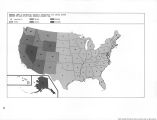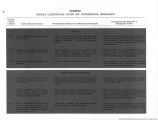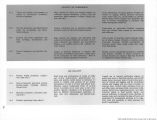| OCR Text |
Show In this approach the entire environment can be viewed as having four major components or elements: water, air, quality experience and the biosystem. Water and air, as fundamental elements of the natural environment need no definition. We suggest a separate category of "quality of experience" that embraces all those intangible visual and aural attributes of our surroundings. This category includes the often overlooked need to reduce noise pollution. Included also is the qualitative effect on the psyche of litter, refuse, overcrowding, and the form and location of constructed works, such as roads, dams, buildings, and powerlines. The fourth category of biosystem is concerned primarily with the living elements of the environment, the vegetation and animal life including their different associations and interrelationships in various locales. It is possible to specify two or more levels of quality for which each of these major components of the environment can and should be maintained or managed. Each quality level could be defined in terms of a purpose or an end to be served by maintaining the particular quality level. To insure continuing quality levels so defined, the desired condition for the four basic categories, i.e., water, biosystem, quality of experience and air must be specified and maintained. The technical conditions suggested as possible guidelines to maintain each quality level might provide the basis for completing the description of each zoning or subcategory. The constraints to be imposed on each type of land use that occurs or is contemplated in each zone would be specified. In sum, the zoning analogy is to be applied. Each major component of the environment would offer variable levels of quality to be maintained for each important environmental element. This in turn would lead to the specification of a set of different degrees of land use constraint for all types of land and resource use for each category. An example of how environmental quality zoning classes could be used in public land administration is set forth in the accompanying table and illustration.11 Any viable system must remain flexible and subject to change and refinement lest it become, like some city zoning measures, a procrustean bed. The utility of this approach lies in the classification of public lands for environmental management using a verifiable method for determining what uses can be 11 The table shows an example of one possible approach to a classification system for environmental management of public lands. The illustration portrays graphically how the classification system might appear if applied to an area of public lands. The Commission is not recommending that this table be adopted without consideration being given to possible alternative approaches. advocated, or what constraints must be placed on uses, in order to achieve a desired level of environmental quality. The desired level of environmental quality and the specific use constraints that are necessary for each area of public lands will be determined by topography, soils, vegetative cover, climate, and the whole calculus of variables peculiar to different public land locations. The area managed need not be designated by size but may be zoned to assure a given level of quality maintenance within each major component of the environment.12 Land Use Planning Includes Environmental Factors Recommendation 19: Congress should specify the kinds of environmental factors to be considered in land use planning and decision-making, and require the agencies to indicate clearly how they were taken into account. The National Environmental Policy Act13 does not define the term "environment," nor is it defined in any other Federal statute, although there are many of them that are addressed to environmental matters. We think that clarification of the term would be desirable as a general principle, and would be particularly appropriate in setting forth the environmental factors to be considered in Federal land use planning. Thus, in such planning, the public land agencies should consider the impact of possible uses of land on the land itself, as well as on air, water, climate, vegetation, wildlife, and man, the latter from the viewpoint of his health and safety, his economic well-being, and his esthetic sense. The National Environmental Policy Act requires a "detailed statement" on the environmental impact of, and possible alternatives to, proposed actions "in every report on proposals for legislation and other major Federal actions significantly affecting the quality of the human environment." (Emphasis supplied.) We endorse that principle. However, we would also apply it to all public land use plans and decisions, not only to those deemed by the land manager to be "major." There should be a record available with all such plans and decisions, from which can be determined the extent to which environmental factors were considered. This should be accepted as a normal process in land management. (Text continued on page 80.) 12 Two studies conducted under contract for the Commission described alternative approaches to systematic classification of environmental quality and related factors. Landscapes, Inc., Environmental Quality and the Public Lands. PLLRC Study Report, 1970. Steinitz Rogers Associates, Inc., A General System for Environmental Resource Analysis. PLLRC Study Report, 1970. 18 n. 3, supra. 77 |







































































































































































































































































































































































